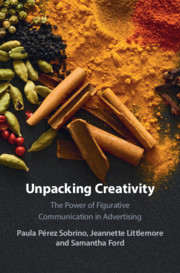Book contents
- Unpacking Creativity
- Unpacking Creativity
- Copyright page
- Dedication
- Contents
- Figures
- Tables
- Acknowledgements
- Introduction
- Part I Theoretical Perspectives
- 1 The Temple of Heaven Is Not China
- 2 Is It a Bird or Is It a Chameleon?
- 3 Welcome to the Black Supermarket
- 4 I Thought They Were Hairy Breasts!
- Part II Empirical Studies
- Notes
- Appendix
- References
- Secondary References
- Index
3 - Welcome to the Black Supermarket
How Do Advertisers Draw the Viewer In? Entering, Experiencing, and Interacting with the Metaphor
from Part I - Theoretical Perspectives
Published online by Cambridge University Press: 14 August 2021
- Unpacking Creativity
- Unpacking Creativity
- Copyright page
- Dedication
- Contents
- Figures
- Tables
- Acknowledgements
- Introduction
- Part I Theoretical Perspectives
- 1 The Temple of Heaven Is Not China
- 2 Is It a Bird or Is It a Chameleon?
- 3 Welcome to the Black Supermarket
- 4 I Thought They Were Hairy Breasts!
- Part II Empirical Studies
- Notes
- Appendix
- References
- Secondary References
- Index
Summary
Chapter 3 explores how and under what conditions consumers interact with figurative language in advertising and respond to it on a deeper, more emotional level. It shows how metaphor and metonymy can be used in emotional, powerful and memorable ways that encourage consumers to ‘interact’ with the narrative, thus provoking deeper and more emotional bonds with the product or brand. It shows how metaphor has the potential to be ‘experienced’ rather than simply encountered, and outlines the factors that are most likely to lead to this. Four campaigns are analysed, each of which was a Grand Prix winner at the Cannes Lions Festival in 2019. The analysis shows how they harness and maximise the experiential potential of metaphor, thus increasing the effectiveness of the campaign. Each of these campaigns illustrates a different way in which the experiential nature of metaphor and metonymy can be enhanced in order to maximise the appeal of an advertising campaign, convey the personality and values of a brand, and build the relationship that it has with consumers. The chapter also analyses another successful campaign, the 2019 Christmas campaign that was developed by John Lewis and Partners and Waitrose and Partners in the UK, and shows how this campaign combines metaphor and metonymy with humour and dramatic irony in order to maximise interactivity and promote feelings of brand ownership. To sum up, the chapter considers the complex and sophisticated ways in which advertisers employ figurative messaging to involve the viewer in a campaign. The campaigns considered are dynamic and interactive, with some of the more experiential campaigns inviting the viewer to ‘act out’ the metaphor.
Keywords
- Type
- Chapter
- Information
- Unpacking CreativityThe Power of Figurative Communication in Advertising, pp. 58 - 76Publisher: Cambridge University PressPrint publication year: 2021

